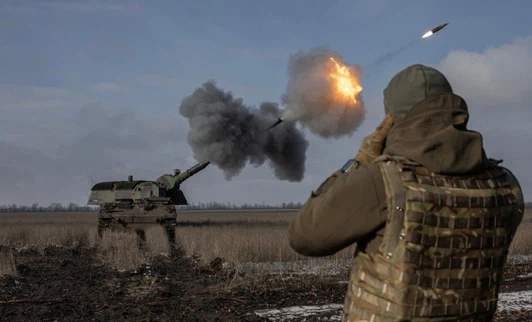As the Russian army rolled on Kyiv in the early days of Russia’s larger assault on Ukraine last February, the beleaguered capital city issued an appeal for volunteers. Thousands of volunteers established a new territorial-defense unit.
A year later, the unit—the 241st Territorial Defense Brigade—is still fighting in what is currently the deadliest section of the war. The frozen slopes and shattered city blocks of Bakhmut, 30 miles north of Donetsk, the rebel Donetsk People’s Republic’s headquarters in eastern Ukraine’s Donbas area.
Since last spring, the Russian army and its mercenary friends from The Wagner Group have been attempting—and so far failing—to conquer Bakhmut, a city with a pre-war population of 70,000 that, other from bordering a few highways, has little strategic relevance.
But it is in Bakhmut that Wagner has chosen to demonstrate the viability of its human-wave assaults—thousands of untrained ex-convicts throwing themselves at Ukrainian positions—and where the Russian army has chosen to begin escalating its operations in Donbas in anticipation of what observers expect to be a much larger winter offensive.
While the Ukrainian army rotates some of its best active heavy brigades into Bakhmut, lightly-armed territorials frequently accompany them, providing troops and deepening fighting experience to the active brigade’s advanced technology and huge weaponry.
The 241st and other territorial brigades travel in machine-gun-equipped pickup trucks and captured Russian tractors, fighting with whatever light armament, infrared sights, radios, and drones they can receive from the Ukrainian military ministry or private benefactors.
Volunteers from many areas of life make up the 241st, as do its sister brigades. IT personnel. Bloggers. Students. Parents. Retirees.
That doesn’t mean the territorials of the 241st aren’t competent troops. The fact that they are all volunteers speaks to their morale, which is undoubtedly the most crucial aspect in the durability of a military force. Particularly in the winter. Even more so in a city-wide war.
However, the territorials are at risk in an increasing conflict due to a shortage of weaponry and armour. It should come as no surprise that the 241st has sustained a high number of casualties in the vicinity of Bakhmut. Expect additional casualties as the struggle moves closer to a climax in the coming days and weeks.
The 241st was founded this spring after tens of thousands of ordinary Ukrainians volunteered for military duty. The brigade’s first training for its motley crew of citizen-soldiers was hurried and inadequate. In May, videos show hundreds of trainees racing across wide fields, rushing into trenches, and shooting their weapons without even securely seating the stocks in their shoulders.
Their enthusiasm, though, was palpable. “I don’t frightened when I know what I’m aiming for,” Yevhen, a 241st territorial, told his brigade’s public-affairs officer.
The immediate threat to Kyiv had subsided by August. The fighting took place in and around Kharkiv, a free city in northern Ukraine, as well as in the south. It is hardly surprising that the 241st moved battalions to Kharkiv while maintaining some troops in Kyiv. When Ukrainian battalions counterattacked near Kharkiv in late August, the Russians retreated, leaving hundreds of armoured vehicles intact.
At least two of the vehicles, MT-LB armoured tractors, were taken by the territorials and added to their arsenal. However, the 241st is still mostly reliant on pickup trucks and private automobiles for movement.
The brigade’s air-defense troops stationed around Kyiv removed some 80-year-old, water-cooled Maxim machine guns from long-term storage and mounted them to pintles in the beds of their trucks.
These air-defenders claimed to have shot down many of Russia’s Iranian-made Shahed suicide drones, including several at night, although it’s difficult to verify such claims.
When a brigade establishes established battle positions while defending an urban strongpoint, a lack of protected mobility isn’t deadly.
Small infantry squads creep among the rubble, fire a few bullets at the oncoming Russians, and then dash to a new position. There is no need for armoured combat vehicles.
However, when the Russians break through, as has happened recently north, east, and south of Bakhmut, the lack of mobility becomes critical. The Russian army and Wagner have resumed their Bakhmut operation, despite tens of thousands of deaths.
Around the New Year, a coordinated Russian onslaught cut off a 241st sub-unit, killed many territorials, and stranded two of the brigade’s injured men behind enemy lines. There was no time to flee before they were overpowered.
They tried to survive for 11 days. “We gathered first-aid supplies from our fallen brethren for dressings,” a territorial dubbed “Nike” explained.
“With little food or drink, we waited for the proper opportunity to return.” By the 12th of January, the two famished territorials had slipped past the Russians and returned to their unit.
The elite 72nd Mechanized Brigade of the Ukrainian army, armed with tanks, combat vehicles, M-109 howitzers, and shoulder-fired Javelin missiles, is responsible for much of the killing in and around Bakhmut.
However, the brigade’s 3,000 troops are unable to defend all of the trenches, bunkers, and underground combat positions. Not with the Russians launching tens of thousands of soldiers against the city.
So the 241st steps in, fortifying Bakhmut’s fortifications until Kyiv determines that it has murdered enough Russians in Bakhmut and that the virtually dead remains are no longer worth defending.
